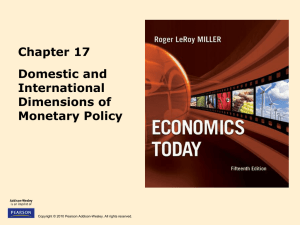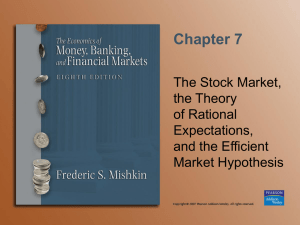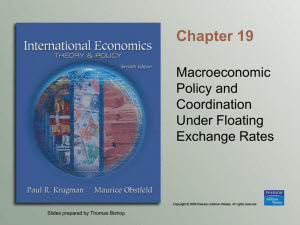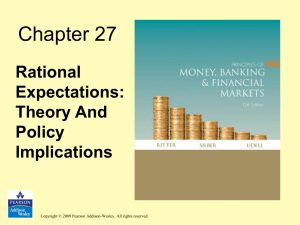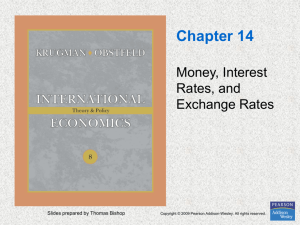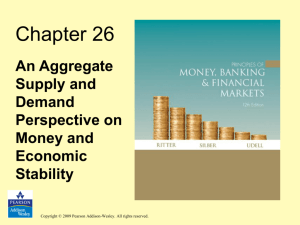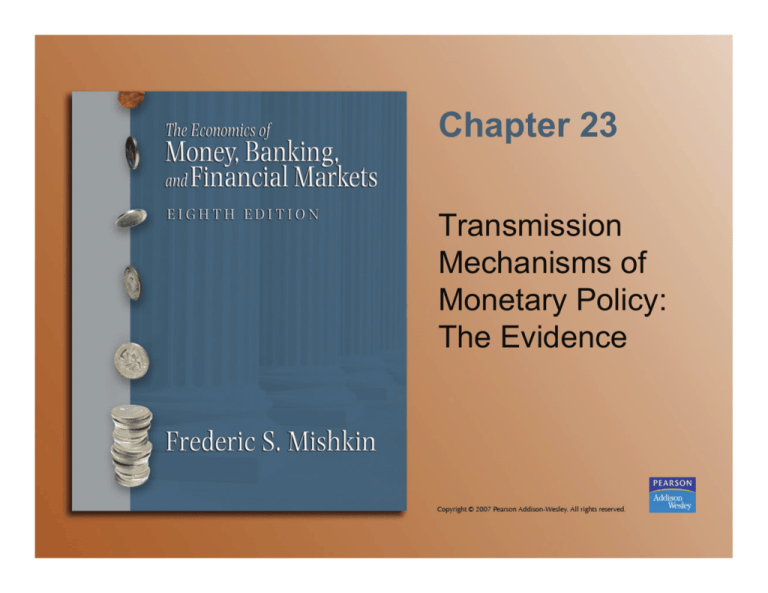
Chapter 23
Transmission
Mechanisms of
Monetary Policy:
The Evidence
Structural Model
• Examines whether one variable affects
another by using data to build a model that
explains the channels through which the
variable affects the other
• Transmission mechanism
The change in the money supply affects
interest rates
Interest rates affect investment spending
Investment spending is a component of aggregate
spending (output)
Copyright © 2007 Pearson Addison-Wesley. All rights reserved.
23-2
Reduced-Form
• Examines whether one variable has an
effect on another by looking directly at
the relationship between the two
• Analyzes the effect of changes in money
supply on aggregate output (spending)
to see if there is a high correlation
• Does not describe the specific path
Copyright © 2007 Pearson Addison-Wesley. All rights reserved.
23-3
Structural Model
Advantages and Disadvantages
• Possible to gather more evidence
more confidence on the direction
of causation
• More accurate predictions
• Understand how institutional changes
affect the links
• Only as good as the model it is based on
Copyright © 2007 Pearson Addison-Wesley. All rights reserved.
23-4
Reduced-Form
Advantages and Disadvantages
• No restrictions imposed on the way
monetary policy affects the economy
• Correlation does not necessarily
imply causation
Reverse causation
Outside driving factor
Copyright © 2007 Pearson Addison-Wesley. All rights reserved.
23-5
Early Keynesian Evidence
• Monetary policy does not matter at all
• Three pieces of structural model evidence
Low interest rates during the Great Depression
indicated expansionary monetary policy but had no
effect on the economy
Empirical studies found no linkage between
movement in nominal interest rates and
investment spending
Surveys of business people confirmed that
investment in physical capital was not based on
market interest rates
Copyright © 2007 Pearson Addison-Wesley. All rights reserved.
23-6
Objections to
Early Keynesian Evidence
• Friedman and Schwartz publish a monetary history
of the U.S. showing that monetary policy was actually
contractionary during the Great Depression
• Many different interest rates
• During deflation, low nominal interest rates do not
necessarily indicate expansionary policy
• Weak link between nominal interest rates and
investment spending does not rule out a strong link
between real interest rates and investment spending
• Interest-rate effects are only one of many channels
Copyright © 2007 Pearson Addison-Wesley. All rights reserved.
23-7
Copyright © 2007 Pearson Addison-Wesley. All rights reserved.
23-8
Timing Evidence of Early Monetarists
• Money growth causes business cycle
fluctuations but its effect on the business cycle
operates with “long and variable lags”
• Post hoc, ergo propter hoc
Exogenous event
Reduced form nature leads to possibility of
reverse causation
Lag may be a lead
Copyright © 2007 Pearson Addison-Wesley. All rights reserved.
23-9
Copyright © 2007 Pearson Addison-Wesley. All rights reserved.
23-10
Statistical Evidence
• Autonomous expenditure variable equal
to investment spending plus government
spending
For Keynesian model AE should be highly
correlated with aggregate spending but money
supply should not
For Monetarist money supply should be highly
correlated with aggregate spending but AE
should not
• Neither model has turned out be more
accurate than the other
Copyright © 2007 Pearson Addison-Wesley. All rights reserved.
23-11
Historical Evidence
• If the decline in the growth rate of the money
supply is soon followed by a decline in output
in these episodes, much stronger evidence is
presented that money growth is the driving
force behind the business cycle
• A Monetary History documents several
instances in which the change in the money
supply is an exogenous event and the change
in the business cycle soon followed
Copyright © 2007 Pearson Addison-Wesley. All rights reserved.
23-12
Copyright © 2007 Pearson Addison-Wesley. All rights reserved.
23-13
Lessons for Monetary Policy
• It is dangerous always to associate the easing
or the tightening of monetary policy with a fall
or a rise in short-term nominal interest rates
• Other asset prices besides those on
short-term debt instruments contain important
information about the stance of monetary
policy because they are important elements in
various monetary policy transmission
mechanisms
Copyright © 2007 Pearson Addison-Wesley. All rights reserved.
23-14
Lessons for Monetary Policy (cont’d)
• Monetary policy can be highly effective in
reviving a weak economy even if short-term
interest rates are already near zero
• Avoiding unanticipated fluctuations in the price
level is an important objective of monetary
policy, thus providing a rationale for price
stability as the primary long-run goal for
monetary policy
Copyright © 2007 Pearson Addison-Wesley. All rights reserved.
23-15




